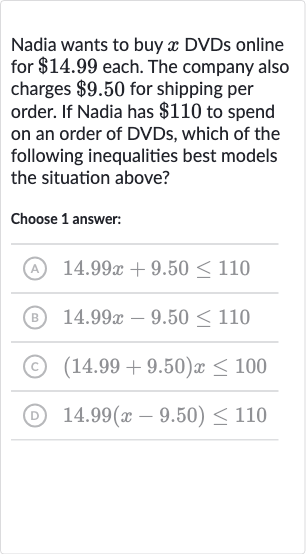Full solution
Q. Nadia wants to buy DVDs online for each. The company also charges for shipping per order. If Nadia has to spend on an order of DVDs, which of the following inequalities best models the situation above?Choose answer:(A) (B) (C) (D)
- Calculate DVD Cost: Nadia wants to buy DVDs at each, so the total cost for the DVDs is , which is represented as .
- Add Shipping Fee: There is also a shipping fee of per order, which is a fixed cost and does not depend on the number of DVDs purchased. This fee is added to the total cost of the DVDs.
- Set Budget Limit: Nadia has to spend on her order. This means that the total cost of the DVDs plus the shipping fee must be less than or equal to .
- Formulate Inequality: Combining the cost of the DVDs and the shipping fee, we get the inequality , which represents the total cost that must not exceed Nadia's budget.
- Check Option (A): Now, we need to check the given options to see which one matches our derived inequality. Option (A) is , which is exactly what we have calculated.
- Evaluate Other Options: Options (B), (C), and (D) do not correctly represent the situation. Option (B) subtracts the shipping fee, which is incorrect. Option (C) incorrectly multiplies the sum of the cost per DVD and the shipping fee by . Option (D) incorrectly applies the shipping fee to the number of DVDs minus .
More problems from Write a linear inequality: word problems
QuestionGet tutor help
QuestionGet tutor help
QuestionGet tutor help
QuestionGet tutor help
QuestionGet tutor help
QuestionGet tutor help
QuestionGet tutor help
QuestionGet tutor help

